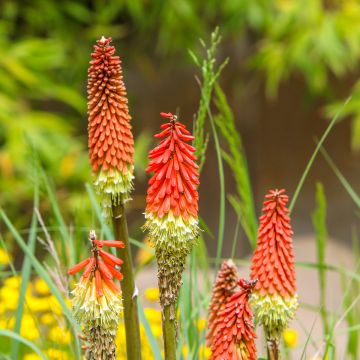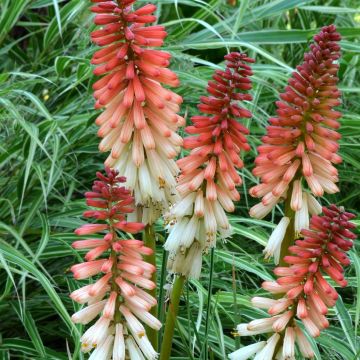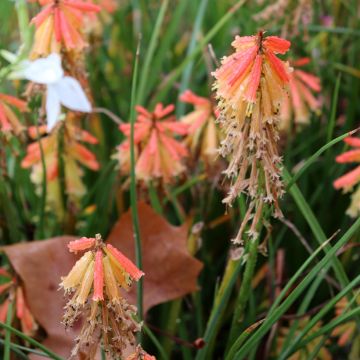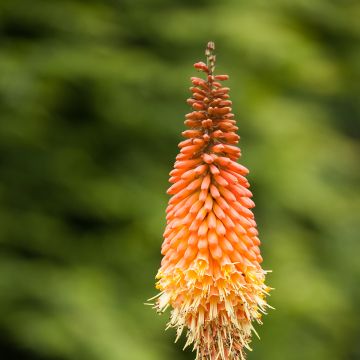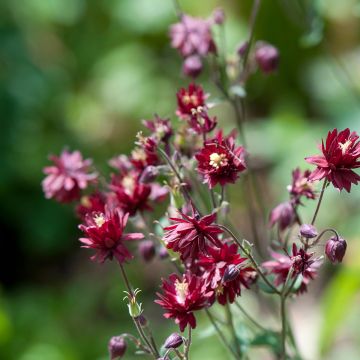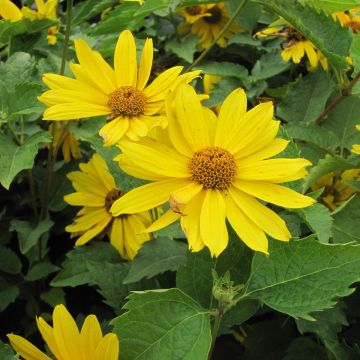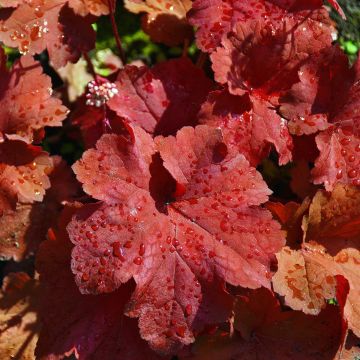

Kniphofia Red Rocket - Red Hot Poker


Kniphofia Red Rocket - Red Hot Poker
Kniphofia Red Rocket - Red Hot Poker
Kniphofia Red Rocket
Red Hot Poker, Tritoma, Torch Lily, Poker Plant
Why not try an alternative variety in stock?
View all →This plant carries a 12 months recovery warranty
More information
We guarantee the quality of our plants for a full growing cycle, and will replace at our expense any plant that fails to recover under normal climatic and planting conditions.
From €5.90 for pickup delivery and €6.90 for home delivery
Express home delivery from €8.90.
Does this plant fit my garden?
Set up your Plantfit profile →
Description
Kniphofia 'Red Rocket' is a stocky dwarf variety, highly appreciated for its bright red floral spikes throughout summer. They emerge from a beautiful cluster of leaves resembling those of grasses. The spikes appear in spring and again in late summer. Red-hot pokers are easy-to-grow perennial plants that make a big impact in the centre or front of flower beds. They thrive in full sun, in well-drained soil.
'Red Rocket' is a horticultural hybrid tritoma belonging to the Asphodelaceae family. It is derived, among others, from Kniphofia uvaria, a perennial plant with fleshy rhizomes native to South and East Africa, which tolerates our cold and wet winters quite well if planted in well-drained soil.
This 'Red Rocket' variety is compact. It forms an upright, slightly tousled tuft of tough ribbon-like leaves from spring onwards, reaching about 35cm (14in) in all directions. The flowering period is particularly long, extending from June to August, rising 50cm (20in) above the foliage on bare stems. The inflorescence, about 15cm (6in) long, resembles a torch in shape, and is both nectar-rich and honey-rich. It is a dense terminal cluster of tubular and pendulous flowers, with a bright red colour throughout, unlike most tritomas. Each 'hot poker' remains decorative for about 3 weeks. The foliage consists of thin and very long leaves, slightly sharp, with a somewhat greyish-green hue. They are grouped in a spreading bunch. The leaves die down in winter.
Their exotic appearance already charmed our grandmothers. Tritomas are surprising plants, yet very sturdy. They light up any garden with their colourful torches. Kniphofia 'Red Rocket' will integrate well into a rockery, paired with magenta red hollyhocks, common sages, grasses like stipa, and Anchusa azurea 'Loddon Royalist' with deep blue flowers. Tritomas go well with light-flowering perennials like catmints, 'Buenos Aires' verbenas, lavenders, or gaura. They can also be planted individually on a lawn, along a pathway, mixing different colours, or combined with dwarf bamboos, yuccas, cannas, and lobelias to create an exotic atmosphere. Tritomas thrive in sunny exposures. They need water in summer but little in winter. It is important to monitor their location and substrate under certain climates. The soil should be rich and well-drained, but not dried out. They tolerate temperatures below -10°C (14°F), but mulching will help them withstand freezing temperatures.
Report an error about the product description
Kniphofia Red Rocket - Red Hot Poker in pictures


Flowering
Foliage
Plant habit
Botanical data
Kniphofia
Red Rocket
Asphodelaceae (Xanthorrhoeaceae)
Red Hot Poker, Tritoma, Torch Lily, Poker Plant
Cultivar or hybrid
Other Kniphofia - Red-Hot Pokers
Planting and care
Plant Kniphofia 'Red Rocket' in a sunny position in well-drained, humus-rich, sandy soil (a mix of leaf compost and coarse sand). In heavy and clayey soil, add 1/3 sand and 1/3 coarse gravel to a mix of compost and topsoil. Although highly resistant, kniphofia does not tolerate excessive winter water: depending on your climate and soil, plant it on a mound or slope to avoid any stagnant water. Slightly moist soil in summer will support flowering. In very hot regions, plant it in the morning sun.
Thrips can cause mottling on the leaves while excessive winter humidity causes root rot.
Planting period
Intended location
Care
-
, onOrder confirmed
Reply from on Promesse de fleurs
Summer flowering perennials
Haven't found what you were looking for?
Hardiness is the lowest winter temperature a plant can endure without suffering serious damage or even dying. However, hardiness is affected by location (a sheltered area, such as a patio), protection (winter cover) and soil type (hardiness is improved by well-drained soil).

Photo Sharing Terms & Conditions
In order to encourage gardeners to interact and share their experiences, Promesse de fleurs offers various media enabling content to be uploaded onto its Site - in particular via the ‘Photo sharing’ module.
The User agrees to refrain from:
- Posting any content that is illegal, prejudicial, insulting, racist, inciteful to hatred, revisionist, contrary to public decency, that infringes on privacy or on the privacy rights of third parties, in particular the publicity rights of persons and goods, intellectual property rights, or the right to privacy.
- Submitting content on behalf of a third party;
- Impersonate the identity of a third party and/or publish any personal information about a third party;
In general, the User undertakes to refrain from any unethical behaviour.
All Content (in particular text, comments, files, images, photos, videos, creative works, etc.), which may be subject to property or intellectual property rights, image or other private rights, shall remain the property of the User, subject to the limited rights granted by the terms of the licence granted by Promesse de fleurs as stated below. Users are at liberty to publish or not to publish such Content on the Site, notably via the ‘Photo Sharing’ facility, and accept that this Content shall be made public and freely accessible, notably on the Internet.
Users further acknowledge, undertake to have ,and guarantee that they hold all necessary rights and permissions to publish such material on the Site, in particular with regard to the legislation in force pertaining to any privacy, property, intellectual property, image, or contractual rights, or rights of any other nature. By publishing such Content on the Site, Users acknowledge accepting full liability as publishers of the Content within the meaning of the law, and grant Promesse de fleurs, free of charge, an inclusive, worldwide licence for the said Content for the entire duration of its publication, including all reproduction, representation, up/downloading, displaying, performing, transmission, and storage rights.
Users also grant permission for their name to be linked to the Content and accept that this link may not always be made available.
By engaging in posting material, Users consent to their Content becoming automatically accessible on the Internet, in particular on other sites and/or blogs and/or web pages of the Promesse de fleurs site, including in particular social pages and the Promesse de fleurs catalogue.
Users may secure the removal of entrusted content free of charge by issuing a simple request via our contact form.
The flowering period indicated on our website applies to countries and regions located in USDA zone 8 (France, the United Kingdom, Ireland, the Netherlands, etc.)
It will vary according to where you live:
- In zones 9 to 10 (Italy, Spain, Greece, etc.), flowering will occur about 2 to 4 weeks earlier.
- In zones 6 to 7 (Germany, Poland, Slovenia, and lower mountainous regions), flowering will be delayed by 2 to 3 weeks.
- In zone 5 (Central Europe, Scandinavia), blooming will be delayed by 3 to 5 weeks.
In temperate climates, pruning of spring-flowering shrubs (forsythia, spireas, etc.) should be done just after flowering.
Pruning of summer-flowering shrubs (Indian Lilac, Perovskia, etc.) can be done in winter or spring.
In cold regions as well as with frost-sensitive plants, avoid pruning too early when severe frosts may still occur.
The planting period indicated on our website applies to countries and regions located in USDA zone 8 (France, United Kingdom, Ireland, Netherlands).
It will vary according to where you live:
- In Mediterranean zones (Marseille, Madrid, Milan, etc.), autumn and winter are the best planting periods.
- In continental zones (Strasbourg, Munich, Vienna, etc.), delay planting by 2 to 3 weeks in spring and bring it forward by 2 to 4 weeks in autumn.
- In mountainous regions (the Alps, Pyrenees, Carpathians, etc.), it is best to plant in late spring (May-June) or late summer (August-September).
The harvesting period indicated on our website applies to countries and regions in USDA zone 8 (France, England, Ireland, the Netherlands).
In colder areas (Scandinavia, Poland, Austria...) fruit and vegetable harvests are likely to be delayed by 3-4 weeks.
In warmer areas (Italy, Spain, Greece, etc.), harvesting will probably take place earlier, depending on weather conditions.
The sowing periods indicated on our website apply to countries and regions within USDA Zone 8 (France, UK, Ireland, Netherlands).
In colder areas (Scandinavia, Poland, Austria...), delay any outdoor sowing by 3-4 weeks, or sow under glass.
In warmer climes (Italy, Spain, Greece, etc.), bring outdoor sowing forward by a few weeks.

































